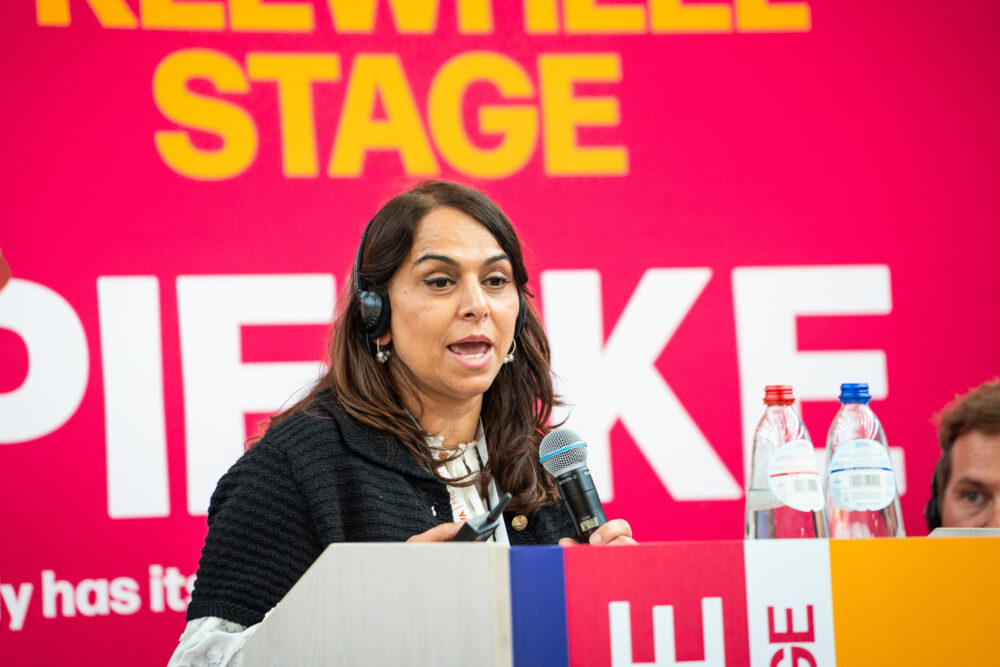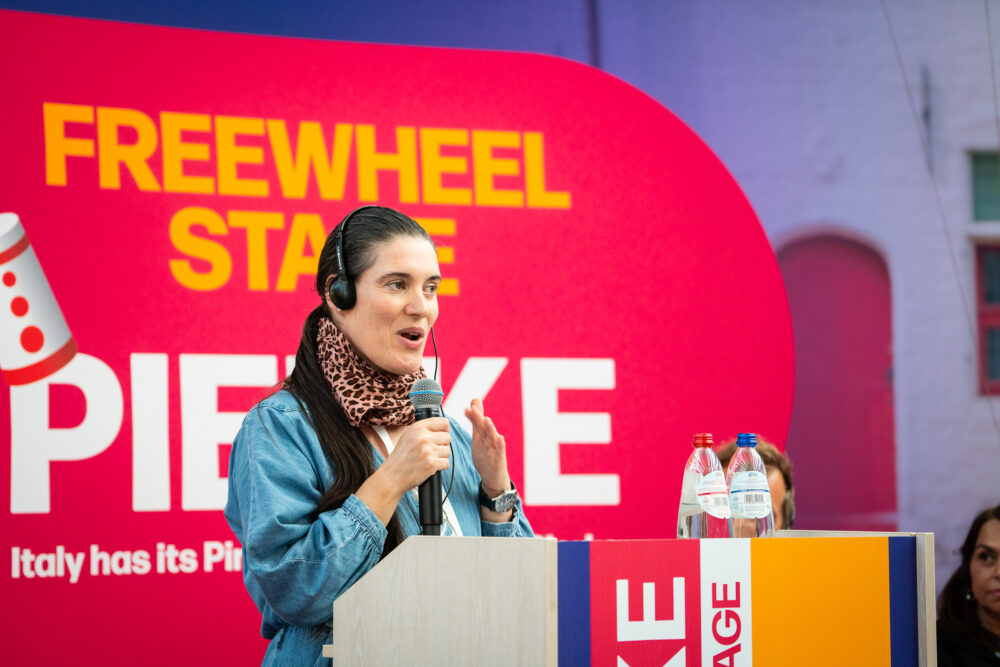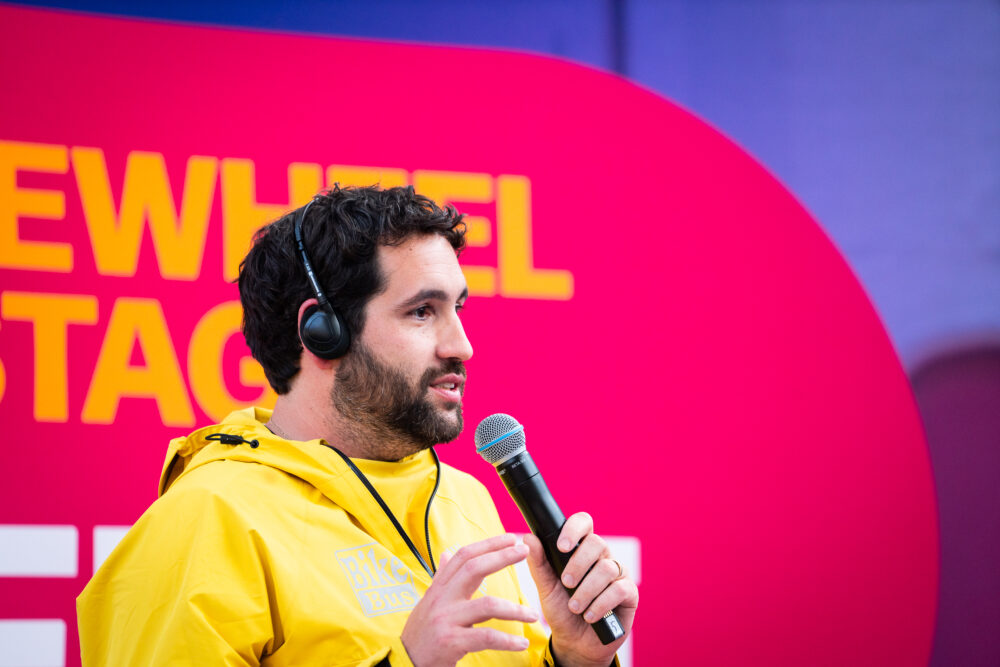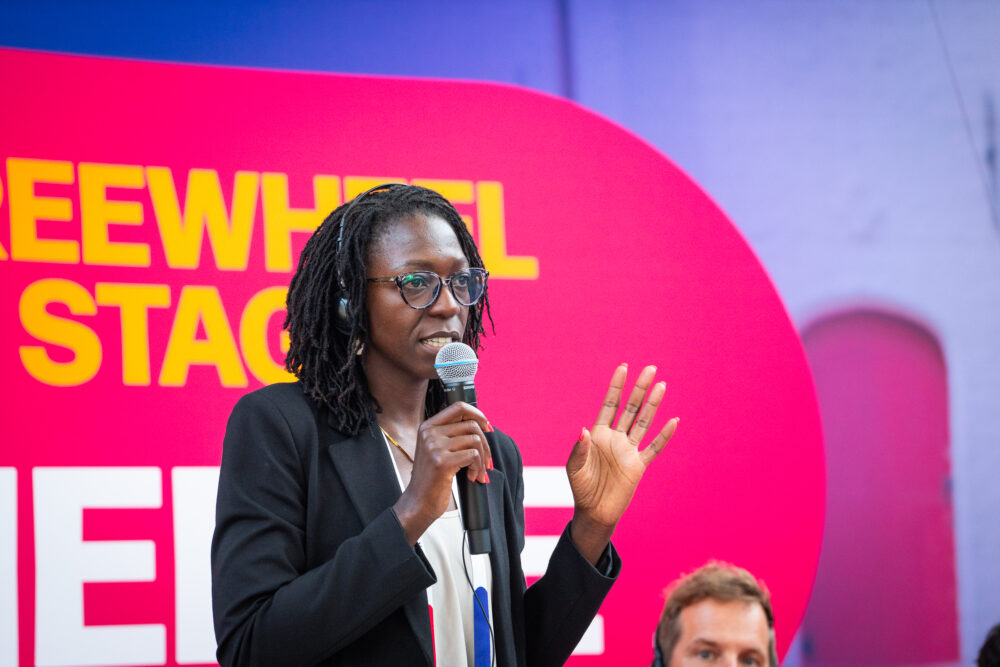Using cycling as a platform to bring communities together is a subject close to our hearts. Whether it’s grassroots campaigning to kickstart a Bikehangar scheme or experiencing the joy of cycling in a big group, we believe cycling is best when we band together.
A team from Cyclehoop attended the Velo-City conference in Ghent, Belgium. We wanted to showcase some of the amazing people we’ve met through cycling and share stories of the work they’ve done to bring people together on two (or more) wheels. Our panel was titled ‘From bike bus to BMX: Creating resilient communities by making cycling fun and safe’.
Chaired by Cyclehoop US CEO Andy Lambert, the panel featured four inspiring speakers:
- Naseem Akhtar – CEO, Saheli Hub
- Sarah Toone – National Standards Cycling Instructor and BMX Coach
- Sam Balto – Alameda Bike Bus
- Cyprine Odada – Executive Director, Critical Mass Nairobi
Naseem Akhtar – CEO Saheli Hub
Naseem is the founder and CEO of Saheli hub, an organisation in Birmingham dedicated to improving health and wellbeing through a range of services including cycling, fitness classes and running. Pioneers in ‘Women only’ sport and fitness, Saheli hub use their cultural expertise to create programs that cater for a range of backgrounds and ethnicities.

In her presentation, Naseem explained how she built Saheli Hub into its current form, beginning with a club for girls delivering activities including rock-climbing, skiing and canoeing.
“I wanted the next generation to have the opportunity to go beyond ‘from home to school and school to home’. For a generation of ethnic minorities, especially Pakistani and Indian women, that’s all we’ve ever done.”
After six months of activities, the group set their sights on even more adventurous activities, including trips to Wales and quad biking.
“If you give people opportunities and chances, you widen their horizons”
Representation is key
Naseem emphasized the importance of representation; how young people need to see their communities participating in cycling and sport to realise that it is an option.
“If I can’t show it, I can’t grow it. If I don’t have role models in my community, if I don’t have women on bikes, then it’s alien to them.”
Naseem began working with the National Lottery and Sport England to create a health and fitness facility for women, run by women. The key performance indicator was to have 250 women participating within a year. The centre had 265 women participating in the first two weeks.
“That’s what connection to the community does.”
Saheli hub works with 2,500 women every year and have taught over 3,000 women to cycle. Naseem urges governments and NGOs to engage with community groups and to design programs that will reach all demographics.
“If you get the offering right for those who are least likely to participate, the rest will be easy.”
“Support grassroots organisations who have the connection, they understand the culture of the community. They know what is needed and how to deliver it, that’s the key.”
Naseem ended the presentation with a message about the far-reaching effect of empowering women:
“If you educate a woman, you educate a family, a generation, a community.”
Sarah Toone – National Standards Cycling Instructor and BMX Coach
Throughout her career as a cycling instructor and education professional, Sarah has built communities and fostered inclusion with a range of different programs. She is a qualified BMX coach, one of only three in the country at the time.

BMX is a set of cycling disciplines usually undertaken on small bikes with 20” wheels. Disciplines include racing on a track composed of jumps and banked corners, and freestyle, often in a skatepark. With new skills and techniques to learn, it’s a fun and challenging way to enjoy cycling.
As part of the 2012 London Olympic legacy, a BMX track was built in Sarah’s home borough. She was chosen to create a BMX service, working for the leisure centre in collaboration with the borough council, local schools, local BMX Club and the local community.
Much of Sarah’s work focuses on inclusion, with sessions run specifically for women and girls, pan disability cycling and at-risk youth.
Sport as a tool for inclusion
The Women on Wheels program was designed to reach women who needed a more active lifestyle, teaching them to ride and use cycling as an everyday mode of transport. It illustrates how cycling can create lasting connections and communities:
“The majority could not ride a bike when they started in 2016. They are still going strong today. One of the ladies who learnt to ride with us now runs the group.”
Sarah uses BMX as an engagement tool to help students with behavioral difficulties. The group saw BMX as cool, fun and challenging, and by providing a supportive environment, Sarah helped them engage and collaborate. Some even tapping into high skill levels.
“You can really see how sport impacts young people, building their confidence, building their creativity, giving them space to be themselves. BMX is just hard enough for them to have to pay attention and engage.”
Facilities and activation required for success
Facilities are key to giving communities a venue to try cycling and action sports, however, Sarah points out that activation is a crucial step to unlock their true potential. By running launch events and training local participants, she gives people the opportunity to try the space safely and equips them with the skills to run community clubs.
“When I activated them (BMX tracks, skateparks and sports hubs), I made sure to present the work with girls, pan-disability. I linked up with pupil referral units and schools to give everyone a chance.”
Drawing on years of experience, Sarah developed a training programme for disability and female inclusion for cycling coaches and club leads. The program brings coaches and volunteers together, encouraging them to share and explore both their positive and negative experiences as well as fears and apprehension around inclusion. She explained their ‘test and learn’ approach:
“It’s a case of ‘just start and see what happens’, work with the families, work with the students and you can do wonderful things.”
Sam Balto – Educator and Bike Bus Evangelist
Well known on twitter as @CoachBalto, Sam Balto is a Physical Education Teacher from Portland Oregon, and a spokesperson for the Bike Bus movement in the United States.

A Bike Bus is a coordinated bike ride to and from school led by adults with student participants. They typically have a defined route, and students can join and leave the bus as it passes their destination.
His presentation began with a stark reminder of the background in which many children are growing up: loneliness as a global public health concern, and the school pickup line, a ‘soul-crushing’ daily gridlock of SUVs queueing for hours to drop off and pick up children from school. Both issues are alleviated in part by programmes like Bike Busses.
Balto’s journey began in Boston, where he was looking for ways to introduce more physical activity into his students’ lives. As a teacher supervising the school run, he had the idea of creating a walking school bus.
“That morning when we arrived at school, it was so different to every other morning I experienced as a teacher that ever since I’ve been on this crazy mission to promote active transportation to school.”
After moving to Oregon, Sam had a moment of inspiration as he watched a video of a Bici Bus in Barcelona.
“I joke that I’ve never watched the entire thing, I just saw the first couple of seconds and I just knew this had to be done.”
He went on to organise the first bike bus at his school in the Alameda area of Portland to celebrate Earth Day. Led by Coach Balto on a cargo bike with a booming loudspeaker, the first bike bus was attended by 75 students, about 15% of the student population. With the help of parent volunteers and community members, Coach Balto was able to run the bike bus for the remainder of the school year, with participation numbers doubling.
“It’s about reconnecting communities and providing that freedom and joy and independence that our children so desperately need.”
The Alameda Bike Bus gained widespread attention, a video shared on social media had over 16 million views, leading to national coverage on a range of TV shows. The viral success of the Bike Bus inspired similar schemes across the world including Bergen, Sao Paolo and Hyderabad.
Bike Bus in legislation
As the movement gains momentum, Sam has been able to influence new legislation. Known as the ‘Bike Bus Bill’, HB 3014 gives Oregon school districts greater flexibility to allocate transportation funding. Coach Balto notes that volunteering is an inconsistent and unsustainable approach to staffing Bike Busses, and paid personnel are needed to ensure the programmes continue long term.
Other resources, including an international summit and academic studies are now underway, helping schools and advocates start their own initiatives.
Balto closed with an anecdote about a conversation with his kindergarten aged son, who asked him during a bike bus ride: “Who’s the boss of the Bike Bus? Who told you to do to it?”. Sam replied “Nobody told me to do the Bike Bus, I just wanted to do it. I thought it would be fun, and you and your friends would like it, so we just did it!”. After considering this response, Sam’s son said “Cool! I love the Bike Bus!”
In his conclusion, Balto encourages everyone to push ahead with community projects:
“You don’t need permission to do these things, if you have an idea and you think it would be positive for your community, try it! The community is probably going to pick it up.”
Cyprine Odada – CEO Critical Mass Nairobi
Cyprine introduces herself not as a cyclist, or as the CEO of Critical Mass Nairobi, but as someone who rides bikes. Her presentation focused on how Critical Mass used ‘Bike Trains’ to help transform Nairobi into a cycling city.

As a graduate, she moved to Nairobi and initially felt isolated, but was quickly able to find a community after venturing out into the city by bicycle, meeting like-minded people and becoming involved with Critical Mass.
Beginning in 2014, Critical Mass Nairobi organised monthly group rides, starting out with between 10 and 30 participants. By 2023, numbers had skyrocketed, with hundreds of participants joining each month. However, outside of Critical Mass, cycling was not growing as mode of transport. The group conducted a survey, the results showed that participants felt safe during the group rides but did not feel safe cycling individually.
Cyprine and her team looked for ways to replicate the safety of a group ride in the context of everyday mobility, and the Bike Train was born.
“Our objective from the beginning was to get people back on bicycles. We realised that our policy makers were designing the roads based on the number of road users they could see. We felt this was unfair because a lot of people were cycling, just not at the same time.” “We had to make cyclists visible, we had to get them on the road at the same time so we have images to show that there are cyclists in Nairobi.”
Similar to Bike Buses, Bike Trains are organised group rides with routes, destinations and schedules set to coincide with the work day commute and events like critical mass. Cyprine and her team began to scale this model up for a city with over 4 million inhabitants. The process started with journey mapping.
“Developing a bike train for an entire city is not the easiest task, we wanted to understand people’s travel habits; where do people stay? Where are they working? Our hope was to try and identify a pattern.”
The team surveyed residents manually at the roadside. They found that people were travelling to a wide spread of destinations, with a pattern too complex to cater for. Instead, they opted to bring people into the city centre. They devised twelve routes, catering for different neighbourhoods.
The next step was to create a schedule; the team surveyed cyclists to ascertain how long they would take to reach the city centre from each area. Based on a manageable pace for all participants, the schedule helps riders join the Bike Train with confidence, and also helped children participate in critical mass, particularly those whose parents do not cycle. Parents can take their children to the Bike Train stop at the scheduled time, and set them on their way, in the knowledge that they are safe in the group and supervised by marshals.
With high levels of participation, Nairobi Bike Trains require co-ordination. The Critical Mass Team created WhatsApp groups for each route, with the most popular group numbering over four hundred members. The groups also serve as community hubs, giving members a forum to connect, to ask for help in emergencies and even to get help retrieving stolen bikes.
“The Bike Train has been really great at bringing cyclists from all over Nairobi to create a community and also trust each other.”
While running Critical Mass rides and Bike Trains, Cyprine and her team noticed that women were joining the rides in high numbers, but also leaving after only one or two rides. They sought to understand the reasons behind this.
“It was about speed and safety, the speed at which the men were riding was not suitable for a lot of women. From that, we organised a Critical Mass ride just for women.”
The team organised discussions where women could voice the issues they faced while cycling. They encouraged participants to organise their own social rides, and also to join the main ride.
“It’s been really great because we also support women who are in competitive sport, those who want to work in cycling related businesses and also to just bring women together to talk about things that are important.”
Cyprine concluded with a message of gratitude to her team, and a few words about how Critical Mass Nairobi has inspired rides across Kenya and internationally, even as far as Canada.
“For me, nothing gives me more pleasure than just seeing people on bicycles and experiencing the joy of cycling.”
Strength in numbers
While each of our panellists work in different places with different demographic groups, their stories share unifying threads of courage, collaboration and perseverance. They highlight the importance of local knowledge and experience; each being an integral member of the community they serve. By offering skills, structure and regularity they have built resilient communities of cyclists, and brought them joy, health and lasting connections.

